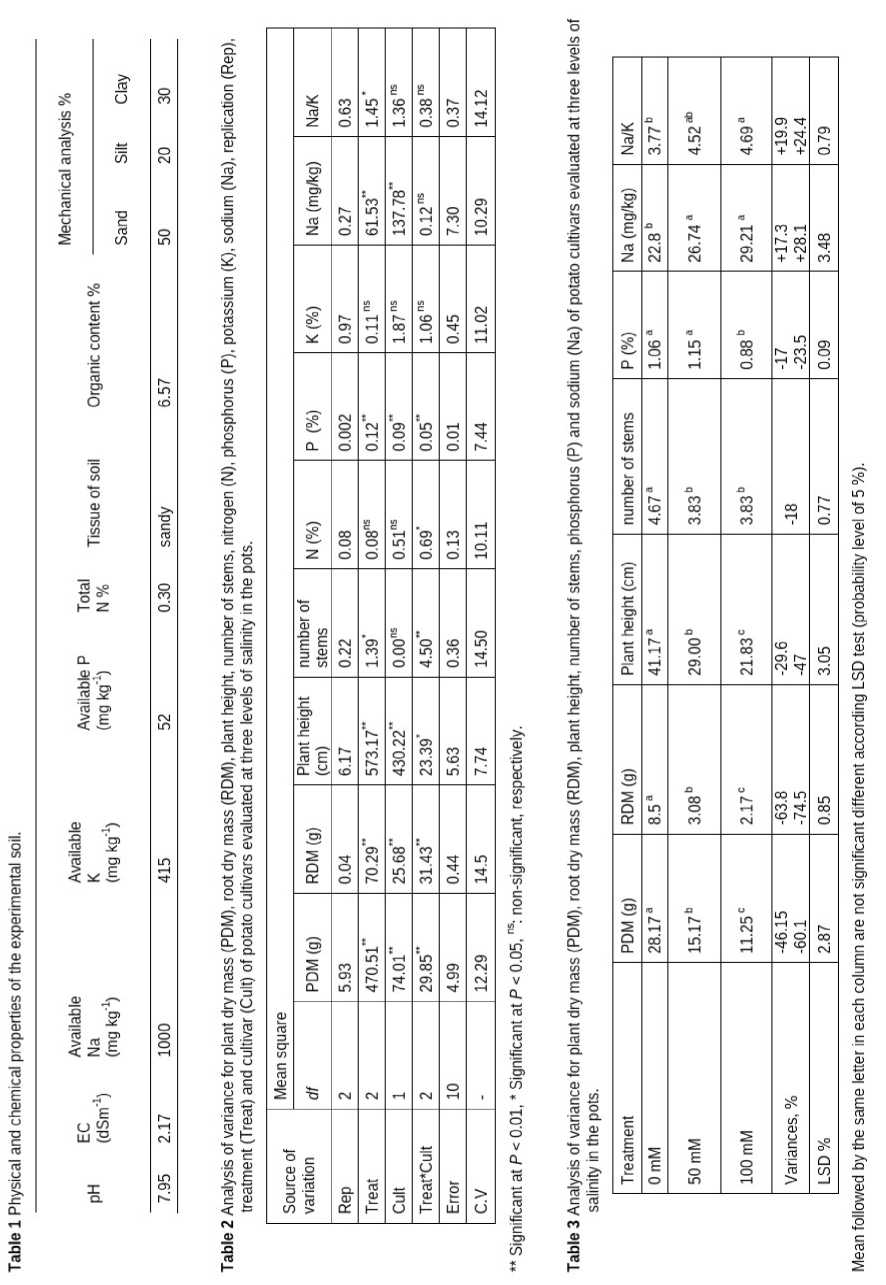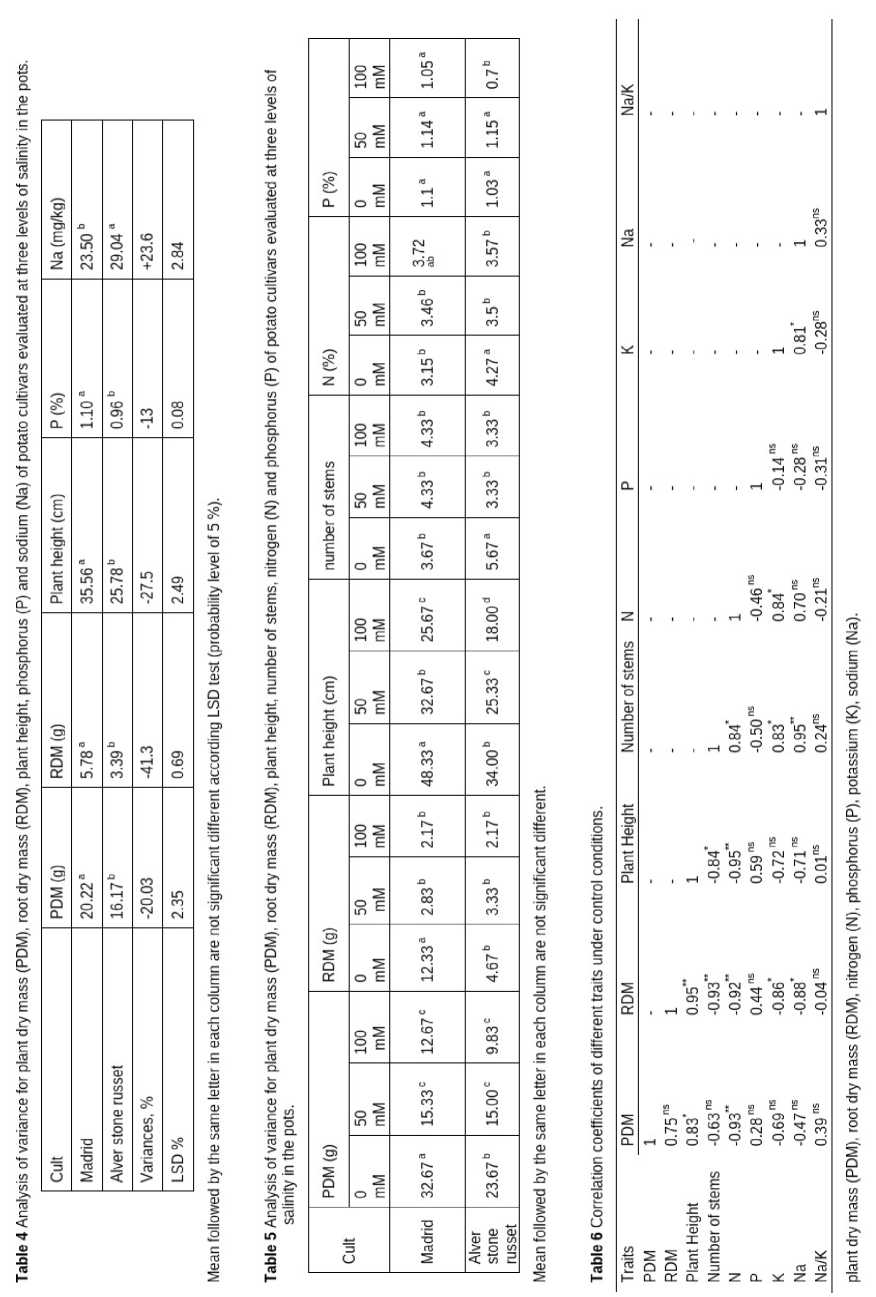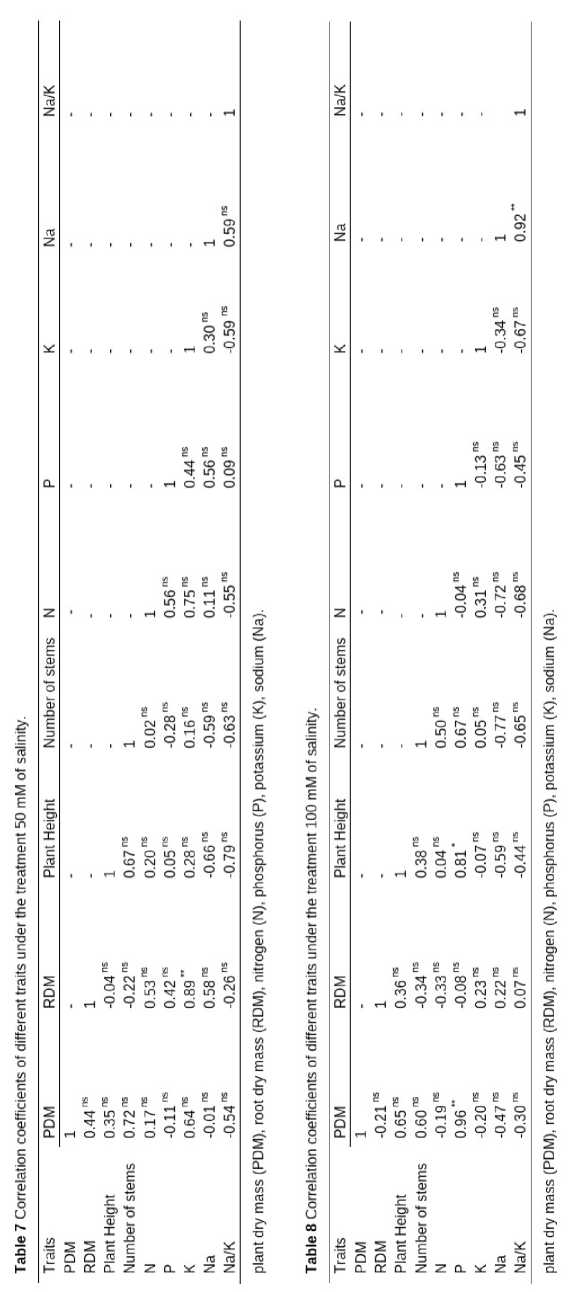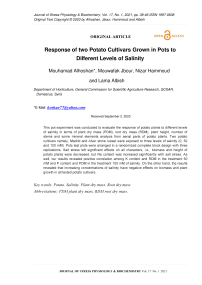Response of two Potato Cultivars Grown in Pots to Different Levels of Salinity
Автор: Mouhamad Alhoshan, Mouwafak Jbour, Nizar Hammoud, Lama Albish
Журнал: Журнал стресс-физиологии и биохимии @jspb
Статья в выпуске: 1 т.17, 2021 года.
Бесплатный доступ
This pot experiment was conducted to evaluate the response of potato plants to different levels of salinity in terms of plant dry mass (PDM), root dry mass (RDM), plant height, number of stems and some mineral elements analysis from aerial parts of potato plants. Two potato cultivars namely, Madrid and Alver stone russet were exposed to three levels of salinity (0, 50 and 100 mM). Pots test plots were arranged in a randomized complete block design with three replications. Salt stress left significant effects on all characters, i.e., biomass and height of potato plants were decreased, but Na content was increased significantly with salt stress. As well, our results revealed positive correlation among K content and RDM in the treatment 50 mM and P content and PDM in the treatment 100 mM of salinity. On the other hand, the results revealed that increasing concentrations of salinity have negative effects on biomass and plant growth in all tested potato cultivars.
Potato. Salinity. Plant dry mass. Root dry mass
Короткий адрес: https://sciup.org/143173875
IDR: 143173875
Текст научной статьи Response of two Potato Cultivars Grown in Pots to Different Levels of Salinity
Abbreviations: PDM plant dry mass, RDM root dry mass.
Plants could be exposed to many biotic and abiotic stresses. However, salinity is one of the most important limiting factors among different environmental constraints which affects plant growth and productivity especially in arid and semi-arid areas of the world (Munns, 2002). As well, more studies indicates that salinity has negative effects on plant metabolism, such as, reduction of water potential, ion imbalances and toxicity, and reduced levels of CO 2 assimilation (Bohnert and Jensen, 1996). Correspondingly, results of Katerji et al ., (2003) indicated that salinity levels as low as 2.3 ds m-1 decrease both growth and tuber yield of potatoes. Furthermore, Eilers et al ., (1995) indicated that increasing of salt levels in the soil solution as soil water is depleted and/ or application of the fertilizers requisite for growth and development of plants are one of the common reasons of salinity in the nature. However, salinity due to sodium chloride (NaCl) is the most common soluble salt in soil compared to the excessive accumulation of ions such as calcium (Ca), magnesium (Mg) and sulfur (S) and it is the most detrimental compound for plant growth and development (Munns and Tester, 2008; Tari et al ., 2013). Morever, the osmotic potential of the soil is decreasing under the saline conditions and leads to reduces absorption of essential ions, such as potassium and nitrate, and decreases the activity of enzymes and in the result effects on the stability membranes of plant cells (Kaya et al ., 2006). Forthermore, Martinez et al ., (1996) indicated that potato plants could be categorized as a moderate sensitive crop to salinity. Also, many researchers observed variations in the sensitivity to saline conditions among potato cultivars (Maas et al ., 1997; Ochat et al ., 1999). Meanwhile, the response of potato plants to the salt stress occurred by increasing synthesis of osmoprotectants such as proline and soluble carbohydrates (Sasiakala and Prasad, 1993; Teixeira and Pereira, 2007). A number of selection indicators were recommended on the basis of genotypes yield or biomass reduction under stress conditions. So, in the present study, we used stress tolerance index (STI), to identify genotypes that produce high biomass under both stress and non-stress conditions (Fernandez, 1992).
However, potato was likely domesticated at least 7,000 years ago near Lake Titicaca at 12,500 feet (Spooner et al ., 2005; Singh and Kaur, 2009) on the border of what is now Peru and Bolivia (Glave, 2001; Singh, 2007) and became the fourth most important food crop after wheat, maize and rice (Vreugdenhil et al ., 2007). Therefore, this investigate was conducted to study some of characters of two potato cultivars and the relationship between these traits in reaction to salinity in the pots.
MATERIALS AND METHODS
Plant material, growing conditions and experimental design
In the current study, a pot experiment based on a randomized complete block design with three replications was conducted from Februry to June 2019 at Algotta research station of general commission for scientific agriculture research, located in Damascus, Syria (33º 24.64ʹ N, 36º 30.87ʹ E and 616 m above the mean sea level) to investigate the effects of application of three salinity levels (0, 50, and 100 mM) on two potato cultivars (Madrid and Alver stone russet). Tubers (about 50-70 gr) were kept at room temperature of 25°C for two weeks to germinate and then cultivated in (35×25 cm) pots. The medium culture was prepared of peat, garden soil and sterilized fermented animal manure with the ratio of 1: 2: 1, respectively. as well as, some samples of the medium culture were prepared for analysing (table 1). All pots were irrigated normally and fertilized with a complete crystal soluble fertilizer of 2020-20 fertinova (a product of MCCI, Jordan). Thus, salt treatment was applied at the stage of forming ten and/or twelve leaves. At the end of the experiment (i.e., 120 days) all parts of potato plants were collected for analysis.
Plant dry mass
At the end of the experiment, all parts of potato plants (shoots and roots) of each cultivar and in each replicate were dried to specify a fixed dry weight.
Stress tolerance index (STI)
This index was used to identify cultivars that produce high plant dry biomass under both salt and non-salt conditions and expressed using the following formula:
STI = ( Y pi × Y si )/( Yp )2
Oven dried grinding 0.5 g sample was taken into 50 ml conical flask and 5 ml HNO 3 + HClO 4 was added into it. After that, it was transferred into digestion chamber for 2.5 hours. Then it was cool down. Again, 20 ml distilled water was added and heated with digestion chamber at 280ºC for 30 minutes. The solution was then transferred into 100 ml volumetric flask with filter paper and made the volume 100 ml (stock solution). 5 ml extract solution in addition with 20 ml distilled water was taken into 50 ml volumetric flask. At last, 1 ml LnCl2 was added and the volume was made 50 ml with distilled water. Finally, reading of Na+ and K+ was taken by atomic absorption spectrophotometer (Bar-Tal et al ., 1991).
Data analysis
The data were tested and subjected to analysis of variance (ANOVA) by using SAS and MSTATC programs to determine the difference among treatments and between cultivars and based on a randomized complete block design. Comparison of means was performed by using LSD test ( p < 0.05) and the correlation coefficients between the traits were done by using PROC CORR of SAS program.
RESULTS
Plant and root dry mass
The interaction effects of cultivars and salinity levels were significant (p < 0.01) on plant dry mass (PDM) and root dry mass (RDM) (Table 2). Under normal conditions of irrigation, the most and least values of PDM were attained in Madrid (32.67 g/plant) and Alver stone russet (23.67 g/plant), and RDM were achieved in Madrid (12.33 g/plant) and Alver stone russet (4.67 g/plant). On the other hand, under salt treatments (50 and 100 mM), the maximum and minimum values of PDM were obtained in Madrid (15.33 g/plant) in the treatment 50 mM of salinity and Alver stone russet (9.83 g/plant) in the treatment 100 mM, also, RDM in Alver stone russet (3.33 g/plant) in the treatment 50 mM of salinity and
(2.17 g/plant) in the treatment 100 mM of the two cultivars, respectively (Table 5). PDM and RDM were significantly reduced in the two cultivars at 50 and 100 mM of salinity compared to the normal conditions. Maximum and minimum reductions were observed (Table 3) at 100 mM (60.1 %) and 50 mM (46.15 %) of salinity for PDM and for RDM (74.5 %) and (63.8 %) as compared to the normal conditions, respectively (Table 3). Stress tolerance index (STI) was calculated to assess salinity tolerance of potato cultivars. The values of STI for cultivars were 0.63 (Madrid), 0.45 (Alver stone russet) in the treatment 50 mM of salinity and 0.52 (Madrid) and 0.29 (Alver stone russet) in the treatment 100 mM, respectively.
Plant height and number of stems
The interaction effects of cultivars and salinity levels were significant ( p < 0.05, p < 0.01) on plant height and number of stems, respectively (Table 2). Under normal conditions of irrigation, the most and least values of Plant height were attained in Madrid (48.33 cm) and Alver stone russet (34.00 cm) and number of stems were achieved in Alver stone russet (5.67) and Madrid (3.67). Yet, under salt treatments (50 and 100 mM), the maximum and minimum values of Plant height were obtained in Madrid (32.67 cm) in the treatment 50 mM of salinity and Alver stone russet (18.00 cm) in the treatment 100 mM, similarly, number of stems in Madrid (4.33) and Alver stone russet (3.33) in all levels of salinity, respectively (Table 5). Plant height and number of stems were significantly reduced in both studied cultivars at 50 and 100 mM of salinity compared to the normal conditions. Maximum and minimum reductions were observed (Table 3) at 100 mM (47.00 %) and 50 mM (29.6 %) of salinity for plant height as compared to the normal conditions, and for number of stems (18.00 %) in all levels of salinity.
Elements analysis of the aerial parts of potato plants
The interaction effects of cultivars and salinity levels were significant (p < 0.05, p < 0.01) on nitrogen (N) and phosphorus (P) contents, respectively (Table 2). Under normal conditions of irrigation, the maximum values of N content was achieved in cultivar Alver stone russet (4.27). Nevertheless, under salt treatments (50 and 100 mM), there is no differences of N content between cultivars. However, the minimum values of P contents was observed at the treatment 100 mM of salinity in Madrid cultivar. On the other hand, sodium content was increased by applying salt treatments. the maximum increasing (28.1%) was achieved in the treatment 100 mM of salinity. Likewise, the percent of Na/K was increased (24.4 %) at 100 mM of salinity as compared to the control (Table 3).



Relationship between the traits presented in table 6, 7,
8. Under control conditions plant
Correlation coefficients between different traits are height was highly and positively correlated with PDM and RDM. Also, RDM was negatively correlated with Na content (Table 6). At the same time under the treatment of salinity (50 mM), the high and the positive correlation was found between RDM and K content in the aerial parts of potato plants (Table 7). Moreover, under the treatment of salinity (100 mM), a positive correlation was obtained between Na content and the percentage of Na/ K. Also, P content was positive correlated with PDM and plant height (Table 8).
DISCUSSION
There are many different environment stresses such as drought, low or high temperature, herbicides, UV radiation… etc, salinity is one of these stresses which limiting crop production in many areas worldwide (Flexas et al ., 2006; Sekmen et al ., 2007). Due to the rarely grown crops, as well potato plants in ideal environments, the current research was therefore appeared to evaluate the response of two potato cultivars to different levels of salinity in terms of changes in plant dry mass, plant height, number of stems and changes in the content of some mineral elements in aerial parts of potato plants under different levels of salinity.
Similar to the findings Khenifi et al ., (2011), our results indicated that PDM and RDM were decreased by increasing levels of salinity (table 5). Also, there are differences in PDM and RDM between the two cultivars. PDM and RDM were higher (20.03 and 41.3 % respectively) in cultivar Madrid than Alver stone russet (table 4). As well as, based on calculated stress tolerance index (values recorded in result section under plant dry mass), cultivar Madrid was better than Alver stone russet under all levels of salinity. In addition to, our study indicated to the positive correlation between RDM and K in the treatment 50 mM of salinity, this means that increasing K content in the roots leads to increasing their biomass (table 7).
Furthermore, in the present study, it was detected decreasing in plant height and number of stems of potato plants after applied different levels of salinity (table 3, 5). Plant height was decreased by about 47 % in treatment 100 mM of salinity as compared to the control (table 3). The same results were reported by many researchers on potato plants (Khenifi et al ., 2011)
and sorghum (Sun et al ., 2014). However, Tari et al ., (2013) indicated that sodium chloride (NaCl) in the soil is the most harmful compound for plant growth and development and causes diverse in physiological, biochemical and metabolic changes in plants, which depending on the duration and severity of salt stress (Gupta and Huang, 2014). Also, it causes cell membrane degradation, reduction of photosynthetic activity and consequently decreases the biomass and other characters of plants (Rahnama et al ., 2010). Moreover, the reduction of plant growth because of salinity can be related to a decrease in plant water absorption as a result of osmotic stress and too, because of Na and Cl induced ionic toxicity and disorders. In addition, a reduction in the amount of necessary elements under this condition (Gupta and Huang, 2014). Actually, the homeostasis of Na and Cl is essential for plants to maintain active growth under saline condition. However, in the present study, it was found that increasing salinity levels to (100 mM) resulted in an increase in Na content (28.1 %) and the ratio of Na/K (24.4 %), meanwhile the content of P (17 %) decreased in the shoots of potato plants (table 3). On the other hand, Na content in Alver stone russet was higher (23.6 %) than its content in Madrid cultivar (table 4).
These findings are in accordance with the increase of Na/K ratio and Na content reported in several crops including potato varieties (Munira et al ., 2015), sunflower (Noreen et al ., 2017), maize and barley(Tufail et al ., 2013), and sorghum (Tari et al ., 2013; Sun et al ., 2014).
However, many studies indicated that salinity reduced N, P and K absorption and their accumulation in plants (Hussein et al., 2010). As well, Rozeff, (1995) showed that decreasing N uptake in plants under saline conditions is possibly caused by the interaction between NO3 and Cl or between Na and NH4. Furthermore, salinity decreases the activity of PO43– by ionic strength and as a result reduced the absorption and content of P in plant tissues (Talke et al., 2003). On the other hand, under saline conditions, increasing Na and Cl in plant tissues occur due to the high ion entry through non-selective cationic channels (NSCC) and anionic channels (Amtmann and Sanders, 1999). As well as, high levels of NaCl ions in the protoplasm cause differences in ions balance and they effect on membrane enzymes; consequently, photophosphorylation and phosphorylation in the respiratory chain and as a result plant produces very little of energy. therefore nitrogen assimilation and protein metabolism are disrupting (Bajguz and Hayat, 2008).
CONCLUSION
In this study, we have been able to gather evidence that salinity has harmful effects on growth, uptake and transfer of essential nutrients into the potato plants. As a result, this investigation has been revealed decreasing in biomass and other growth characters and increasing in the content of Na and the percent of Na/K in the aerial parts of all tested potato cultivars by increasing levels of salinity.
ACKNOWLEDGMENTS
This work was supported by the General Commission for Scientific Agriculture Research, and Department of Horticulture Science. Damascus- Syria.
CONFLICT OF INTEREST
The authors declare no conflicts of interest.
Список литературы Response of two Potato Cultivars Grown in Pots to Different Levels of Salinity
- Allen S.E., Grimshaw H.M. and Rowland A.P. (1986) Chemical analysis. In Methods of plant ecology, ed. By P.D. Moore and S. B. Chapman. Blackwell: Oxford.
- Amtmann A. and Sanders D. (1999) Mechanisms of Nauptake by plant cells. Advan. Botan. Res., 129,75-112.
- Bajguz A. and Hayat S. (2008) Effects of brassinosteroids on the plant responses to environmental stresses. Plant Physiol., 10,1016- 1020.
- Bar-Tal A., Fergenbaun S. and Sparks D.L. (1991) Potassium-salinity interaction in irrigated corn. Irrig. Sci., 12, 27-35.
- Bohnert H.J. and Jensen R.G. (1996) Strategies for engineering water-stress tolerance in plants. Trends Biotech., 14, 89-97.
- Eilers R.G., Eilers W.D., Pettapiece W.W. and Lelyk G. (1995) Salinization of Soil. p. 77-86.
- In Acton, D.F. and Gregorich, I.J. (ed.) The health of our soils. Toward sustainable agriculture in Canada. Centre for Land and Biological Resources Research, Agriculture and Agri-Food Canada.
- Fernandez G.C.J. (1992) Effective selection criteria for assessing stress tolerance. In: Kuo C. G. (Eds.), Proceedings of the international symposium on adaptation of vegetables and other food crops in temperature and water stress, Publication, Tainan, Taiwan.
- Flexas J., Bota J., Galmes J., Medrano H. and Ribas-Carbo, M. (2006) Keeping a positive carbon balance under adverse conditions: responses of photosynthesis and respiration to water stress. Physiol. Planta., 127, 343-352.
- Glave L.M. (2001) The conquest of highlands, in the potato treasure of the andes from agriculture to culture, graves C. (Eds.), Lima: Peru: Inter. Potato Center, 41, 42-51.
- Gupta B. and Huang B. (2014) Mechanism of salinity tolerance in plants: physiological, biochemical, and molecular characterization. Inter. J. Genom.,1:18.
- Hanson W.C. (1950) The photometric determination of phosphorus in fertilizers using the phosphovanadomolybdate complex. J. Sci. of Food and Agri., 1 , 172-173.
- Hussein M.M., Abdel-Kader A.A., Kady K.A., Youssef R.A. and Alva A. K. (2010) Sorghum response to foliar application of phosphorus and potassium with saline water irrigation. J. Crop Improv., 24, 324-36.
- Jackson M.L. (1958) Soil chemical analysis. New Jersey: Prentice-Hall Inc. Englewood Cliffs.
- Katerji N., Van-Hoorn J.W., Hamdy A. and Mastrorilli M. (2003) Salinity effect on crop development and yield, analysis of salt tolerance according to several classification methods. Agric. Water Manage., 62, 37-66.
- Kaya M.D., Okcu G., Atak M., Cikili Y. and Kolsarici O. (2006) Seed treatments to overcome salt and drought stress during germination in sunflower (Helianthus annuus L.). Euro. J. of Agron., 24, 291-295.
- Khenifi M.L., Boudjeniba M. and Kameli A. (2011) Effects of salt stress on micropropagation of potato (Solanum tuberosum L.). Afri. J. of Biotech., 10, 7840-7845.
- Maas E.V., Hoffman G.J. (1997) Crop salt tolerance. J. Irrig. Drain. Div.,103, 115-134.
- Martinez CA, Maestri M, Lani EG (1996) In vitro salt tolerance and proline accumulation in Andean potato (Solanum spp.) differing in frost resistance. Plant Sci. 116, 177-184.
- Munira S., Hossain M.M., Zakaria M., Ahmed J.U. and Islam M.M. (2015) Evaluation of potato varieties against salinity stress in Bangladesh. Inter. J. of Plant and Soil Sci., 6, 73-81.
- Munns R. (2002) Comparative physiology of salt and water stress. Plant Cell Environ., 25, 239- 250.
- Munns R. and Tester M. (2008) Mechanisms of salinity tolerance. Ann. Rev. Plant Biol., 59, 651-81.
- Noreen S., Siddiq A., Hussain K., Ahmad S. and Hasanuzzaman M. (2017) Foliar application of salicylic acid with salinity stress on physiological and biochemical attributes of sunflower (Helianthus annuus L.) crop. Acta Scientiarum Polonorum, 16, 57-74.
- Ochat S.J., Marconi P.L., Radice S., Arnozis P.A. and Caso O.H. (1999) In vitro recurrent selection of potato: production and characterization of salt tolerant cell lines and plants. Plant Cell Tiss. Organ Cult., 55, 1-8.
- Rahnama A., James R.A., Poustini K. and Munns R. (2010) Stomatal conductance as a screen for osmotic stress tolerance in durum wheat growing in saline soil. Funct. Plant Biol., 37, 255-63. doi: 10.1071/FP09148.
- Rozeff N. (1995) Sugarcane and salinity - a review paper. Sugarcane, 5, 8-19.
- Sasiakala D.P.P. and Prasad P.V.D. (1993) Influence of salinity on axillary bud of six lowland tropical varieties of potato (Solanum tuberusum L.). Plant Cell Tissue Organ Cult., 32, 185-191.
- Sekmen A.H., Turkana I. and Takiob S. (2007) Differential responses of antioxidative enzymes and lipid peroxidation to salt stress in salt-tolerant Plantago maritime and salt-sensitive Plantago media. Physiol. Plant., 131, 399-411.
- Singh J. and Kaur L. (2009) Advances in potato chemistry and technology. In Bradshaw J.E. and Ramsay G. (Eds.), Potato origin and Production. 67, pp. 1 -26. Academic Press is an imprint of Elsevier. USA.
- Singh R.J. (2007) Genetic resources, chromosome engineering, and crop improvement series. Vegetable crops. CRC. Taylor and Francis Group. New York.
- Sun Y., Niu G., Osuna-Avila P., Zhao L., Ganjegunte G., Peterson G., Peralta-Videa J. and Gardea-Torresdey J. (2014) Variability in salt tolerance of Sorghum bicolor L. Agric. Sci., 2, 9-21.
- Talke I.N., Blaudez D., Maathuis F.J. and Sanders D. (2003) CNGCs: prime targets of plant cyclic nucleotide signalling? Trends in Plant Sci. 8, 286-93.
- Tari I., Laskay G., Takacs Z. and Poor P. (2013) Response of sorghum to abiotic stresses: A review. J. Agron. and Crop Sci., 199, 264-74. doi: 10.1111/jac.12017.
- Teixeira J. and Pereira S. (2007) High salinity and drought act on an organ-dependent manner on potato glutamine synthetase expression and accumulation. Environ. Exp. Bot., 60, 121-126.
- Tufail A., Arfan M., Gurmani A.R., Khan A. and Bano A. (2013) Salicylic acid induced salinity tolerance in maize (Zea mays. ). Pakistan J. Bot., 45, 75-82.
- Vreugdenhil D., Bradshaw J., Gebhardt C., Govers F., Mackerron D.K.L., Taylor M. and Ross H. (2007) Potato biology and biotechnology.
- In Kirkman M.A., (Eds.) Global Markets for Processed Potato Products. 2, Amsterdam, United Kingdom.


